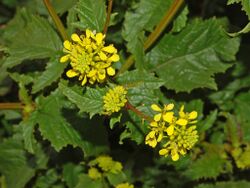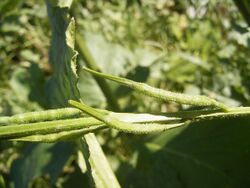Biology:Sinapis arvensis
| Sinapis arvensis | |
|---|---|

| |
| Scientific classification | |
| Kingdom: | Plantae |
| Clade: | Tracheophytes |
| Clade: | Angiosperms |
| Clade: | Eudicots |
| Clade: | Rosids |
| Order: | Brassicales |
| Family: | Brassicaceae |
| Genus: | Sinapis |
| Species: | S. arvensis
|
| Binomial name | |
| Sinapis arvensis | |
| Synonyms[1] | |
| |
Sinapis arvensis, the charlock mustard, field mustard, wild mustard, or charlock, is an annual or winter annual plant of the genus Sinapis in the family Brassicaceae. It is also sometimes referred to as Rhamphospermum arvense[2] and is found in the fields of North Africa, Asia, and Europe. Pieris rapae, the small white butterfly, and Pieris napi, the green veined white butterfly, are significant consumers of charlock during their larval stages.
Description
Sinapis arvensis reaches on average 20–80 centimetres (7.9–31.5 in) of height, but under optimal conditions can exceed one metre. The stems are erect, branched and striated, with coarse spreading hairs especially near the base.[3] The leaves are petiolate (stalked) with a length of 1–4 centimetres (0.39–1.57 in). The basal leaves are oblong, oval, lanceolate, lyrate, pinnatifid to dentate, 4–18 centimetres (1.6–7.1 in) long, 2–5 centimetres (0.79–1.97 in) wide. The cauline leaves are much reduced and are short petiolate to sessile but not auriculate-clasping. It blooms from May to September, or May to August, in the UK.[4] The inflorescence is a raceme made up of yellow flowers having four petals with spreading sepals.[4][5] The fruit is a silique 3–5 cm long with a beak 1–2 cm long that is flattened-quadrangular. The valves of the silique are glabrous or rarely bristly, three to five nerved. The seeds are dark red or brown,[3] smooth 1-1.5 mm in diameter.
Phytochemistry
It contains chemicals of the class glucosinolates, including sinalbin.[6] The seeds contain a plant hormone, Gibberellic acid, which effects the dormancy of the seeds.[7]
Taxonomy
It was formally described by the Swedish botanist Carl Linnaeus in his seminal publication 'Species Plantarum' on page 668 in 1753.[8][9]
It is commonly known as charlock mustard,[10] field mustard,[11] wild mustard,[12] or charlock.[3][4]
Etymology
The generic name Sinapis derives from the Greek word sinapi meaning 'mustard' and was the old name used by Theophrastus for any mustard. The species name arvensis is a Latin adjective meaning 'from/of the field'.[13][14]
Distribution
A native of the Mediterranean basin, from temperate regions of North Africa, Europe and parts of Asia. It has also become naturalised throughout much of North America, South America, Australia, Japan and South Africa.[12]
Range
It is found in North Africa, within Algeria, Egypt, Libya, Morocco and Tunisia. Within Asia, it is found in Arabian Peninsula (in Kuwait, Oman, Qatar, Saudi Arabia and the United Arab Emirates), Armenia, Azerbaijan, the Caucasus, China , Georgia, Iran, Iraq, Israel, Jordan, Kazakhstan, Kyrgyzstan, Lebanon, Siberia, Syria, Tajikistan, Turkmenistan and Uzbekistan. It is also found in tropical Pakistan . In eastern Europe, it is found within Belarus , Estonia, Latvia, Lithuania, Moldova and Ukraine . In middle Europe, it is in Austria, Belgium, the Czech Republic, Germany , Hungary, the Netherlands, Poland , Slovakia and Switzerland . In northern Europe, in Denmark , Finland , Ireland, Norway , Sweden and the United Kingdom . In southeastern Europe, within Albania, Bosnia and Herzegovina, Bulgaria, Croatia, Greece, Italy, Montenegro, North Macedonia, Romania, Serbia and Slovenia. Also in southwestern Europe, it is found in France , Portugal and Spain .[12]
Habitat
It grows in the plains and mountains, in pastures, fields, roadsides, waste places (such as railways, tips, and waste ground[4]), and ruins, but mainly in cultivated places.[3] It prefers calcareous soils in sunny places, at an altitude of 0–1,400 metres (0–4,593 ft) above sea level.
Ecology
The flowers are pollinated by various bees like Andrena agilissima and flies (entomophily). Sinapis arvensis is the host plant of the caterpillars of some Lepidoptera, such as the small white, Pieris rapae. The seeds are toxic to most animals, except birds, and can cause gastrointestinal problems, especially if consumed in large quantities.
It is a highly invasive species in states such as California .[15]
Uses
The leaves of wild mustard are edible at the juvenile stage of the plant;[11] they are usually boiled,[4] such as in 18th century, in Dublin, where it was sold in the streets.[3] During the Great Famine of Ireland, wild mustard was a common famine food, even though it often caused stomach upset.[16][17][18] Once the seeds are ground, they produce a kind of mustard.[11]
A type of oil can be extracted from the seed which has been used for lubricating machinery.[4]
As ruminant feed
Grazing wild mustard at growing and flowering stages is harmless for cattle and sheep. Poisoning can occur in the same animals when fed with older seed-wearing plants. This can occur when wild mustard grows as a weed in green-fed rapeseed or cereals. Accidental consumption of wild mustard oil can also be the cause of reported intoxications.[19]
See also
- Sinapsis alba, known as "yellow mustard" or "white mustard"
References
- ↑ "Sinapis arvensis L.". Board of Trustees of the Royal Botanic Gardens, Kew. 2017. http://powo.science.kew.org/taxon/urn:lsid:ipni.org:names:288960-1#synonyms.
- ↑ "Rhamphospermum arvense (L.) Andrz. ex Besser" (in en). http://powo.science.kew.org/taxon/urn:lsid:ipni.org:names:288569-1.
- ↑ 3.0 3.1 3.2 3.3 3.4 Reader's Digest Field Guide to the Wild Flowers of Britain. Reader's Digest. 1981. p. 42. ISBN 9780276002175.
- ↑ 4.0 4.1 4.2 4.3 4.4 4.5 "Charlock Sinapis arvensis". plantlife.org.uk. https://www.plantlife.org.uk/uk/discover-wild-plants-nature/plant-fungi-species/charlock. Retrieved 9 November 2017.
- ↑ Parnell, J. and Curtis, T. 2012.Webb's An Irish Flora,ISBN:978-185918-4783
- ↑ Popova, I.E.; Morra, M.J. (5 November 2014). "Simultaneous quantification of sinigrin, sinalbin, and anionic glucosinolate hydrolysis products in Brassica juncea and Sinapis alba seed extracts using ion chromatography". J Agric Food Chem 62 (44): 10687–93. doi:10.1021/jf503755m. PMID 25314611.
- ↑ Edwards, Miriam (1976). "Dormancy in Seeds of Charlock (Sinapis arvensis L.)". Plant Physiol. 58 (5): 626–630. doi:10.1104/pp.58.5.626. PMID 16659732.
- ↑ "Sinapis arvensis L. is an accepted name". theplantlist.org. 23 March 2012. http://www.theplantlist.org/tpl1.1/record/kew-2476411. Retrieved 9 November 2017.
- ↑ "Brassicaceae Sinapis arvensis L.". ipni.org. http://www.ipni.org/ipni/idPlantNameSearch.do?id=288960-1. Retrieved 9 November 2017.
- ↑ "Sinapis arvensis". Natural Resources Conservation Service PLANTS Database. USDA. https://plants.usda.gov/core/profile?symbol=SIAR4. Retrieved 15 November 2015.
- ↑ 11.0 11.1 11.2 "Wild Mustard". wildfooduk.com. http://www.wildfooduk.com/hedgerow-food-guide/wild-mustard-hedgerow/. Retrieved 9 November 2017.
- ↑ 12.0 12.1 12.2 "Taxon: Sinapis arvensis L.". ars-grin.gov. https://npgsweb.ars-grin.gov/gringlobal/taxonomydetail.aspx?id=33965. Retrieved 9 November 2017.
- ↑ Archibald William Smith A Gardener's Handbook of Plant Names: Their Meanings and Origins, p. 46, at Google Books
- ↑ Gledhill D. 1985. The Names of Plants. Cambridge University Press. ISBN:0521366755
- ↑ "Plant Assessment Form Sinapis arvensis". cal-ipc.org. 2017-10-03. http://www.cal-ipc.org/plants/paf/sinapis-arvensis-plant-assessment-form/. Retrieved 9 November 2017.
- ↑ McBride, Doreen (8 February 2018). The Little Book of Fermanagh. History Press. ISBN 9780750985406. https://books.google.com/books?id=ArU5DwAAQBAJ&q=charlock+famine&pg=PT104.
- ↑ Gribben, Arthur (1 March 1999). The Great Famine and the Irish Diaspora in America. Univ of Massachusetts Press. p. 31. ISBN 1558491732. https://archive.org/details/greatfamineirish00arth.
- ↑ "Holdings: Nettles and charlock as famine food.". 1959. http://sources.nli.ie/Record/PS_UR_061058.
- ↑ Gustav Rosenberger (1970). Krankheiten des Rindes (1st ed.). Berlin and Hamburg: Verlag Paul Parey. pp. 1271-1272 (Sinapis poisoning). ISBN 3-489-55716-6.
- Environmental Library of the US Army Corps Engineers
- Conti F., Abbate G., Alessandrini A., Blasi C., 2005. An annotated checklist of the Italian vascular flora, Palombi Editore
- Pignatti S. - Flora d'Italia – Edagricole – 1982. Vol. I, pag. 473
External links
- Arkive
- Plants
- Sinapis arvensis
- Sinapis arvensis Flowers in Israel
- "Sinapis arvensis", Calflora: Information on California plants for education, research and conservation, with data contributed by public and private institutions and individuals, including the Consortium of California Herbaria, Berkeley, California: The Calflora Database, https://www.calflora.org/cgi-bin/species_query.cgi?where-taxon=Sinapis+arvensis
- "Sinapis arvensis". http://www.pfaf.org/user/Plant.aspx?LatinName=Sinapis+arvensis.
Wikidata ☰ Q27986 entry








